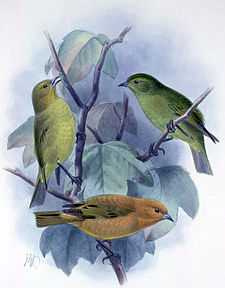Maui ʻAkepa
| Maui Ākepa | |
|---|---|
 | |
| Conservation status | |
| Scientific classification | |
| Kingdom: | Animalia |
| Phylum: | Chordata |
| Class: | Aves |
| Order: | Passeriformes |
| Family: | Fringillidae |
| Genus: | Loxops |
| Species: | L. coccineus |
| Subspecies: | L. c. ochraceus |
| Trinomial name | |
| Loxops coccineus ochraceus Rothschild, 1893 | |
The Maui Akepa (Loxops coccineus ochraceus) is an extinct finch-like bird once native to Maui in the Hawaiian Islands, and which was common throughout the island.
Description
It was a four inch (10 cm) long bird of a dusty green color. It had a small cross bill just like the other Loxops species. Its call was a slight quivering whistle ending with a long trill. It appeared as a small fast moving ball of fluff of green, as it flew from tree to tree.
Feeding
It ate spiders and other invertebrates and drank the nectar of several flowers including the nectar of the O’hia, the Naio and the lobelia.
Extinction
Like may birds in the area, its condition as a species began to deteriorate as new plants replaced those that it was familiar with. Many of these plants included raspberries which literally choked out the native growth and made itself an invincible plant. Those plants had also carried frogs and insects that began to eat the native insects, causing the Maui Akepa to lose much of its food supply, the introduced carriers had also brought more problems with them, for example more pests. The Maui Akepa was also a frail bird when it came to resistance to diseases like Avian flu which was spreading at a rapid pace as the mosquito spread across the islands low elevation forests.
Extinction started in the early 20th century when the Maui Akepa was still a common bird on much of Maui. However mosquitoes and other animals and plants arrived on ships and colonized the island. The bird became constricted as more of its low elevation forest became colonized by mosquitoes. The upper elevations began to be filled with unusual plants and animals which destroyed the habitat. With much of Maui changed, the birds had a difficult time trying to find places in which they could live.
The idea of captive breeding had not expanded to these songbirds until 1995, but by then the Maui Akepa was already gone in the year of 1988, where only one was sighted that year when a party of people went on a research trip to study birds that are found on Maui’s Hanawi Reserve. Before that there were several other ventures that showed small populations scattered on the Reserve. The largest population found in the 1970s contained ten Maui 'Akepa. Today the Maui 'Akepa can only seen as a specimen in one of the famous museums across the world. During the 1970s this species was still surviving in small numbers in the East Maui Watershed, and in the reserves that are found in or near the Watershed.
This birds stand as being a species has been under attack over the years. Many people believe that if the Kauai Akepa or Akeke’e is a separate species then why shouldn’t the Oahu and Maui forms. Scientists say that these forms were not different enough to be two separate species from Loxops coccinea or the Hawaiian Akepa and should just be considered as two subspecies of the Hawaiian Akepa.
See also
References
- Loxops coccineus ochraceus BirdLife International 2004
- 2006 IUCN Red List of Threatened Species. Downloaded on 19 July 2007.
